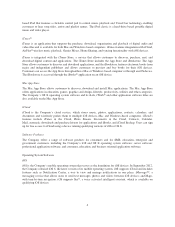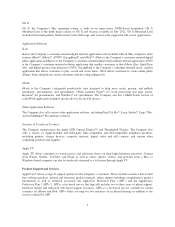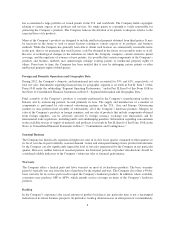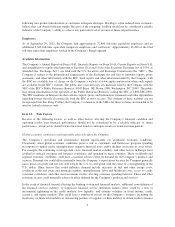Apple 2012 Annual Report Download - page 14
Download and view the complete annual report
Please find page 14 of the 2012 Apple annual report below. You can navigate through the pages in the report by either clicking on the pages listed below, or by using the keyword search tool below to find specific information within the annual report.may seek to limit the Company’s access to, or increase the cost of, such content. The Company may be unable to
continue to offer a wide variety of content at reasonable prices with acceptable usage rules, or continue to expand
its geographic reach.
Many third-party content providers require the Company to provide digital rights management and other security
solutions. If requirements change, the Company may have to develop or license new technology to provide these
solutions. There is no assurance the Company will be able to develop or license such solutions at a reasonable
cost and in a timely manner. In addition, certain countries have passed or may propose and adopt legislation that
would force the Company to license its digital rights management, which could lessen the protection of content
and subject it to piracy and also could negatively affect arrangements with the Company’s content providers.
The Company is frequently involved in intellectual property litigation, and could be found to have infringed on
intellectual property rights.
Technology companies, including many of the Company’s competitors, frequently enter into litigation based on
allegations of patent infringement or other violations of intellectual property rights. In addition, patent holding
companies seek to monetize patents they have purchased or otherwise obtained. As the Company has grown, the
intellectual property rights claims against it have increased and may continue to increase. In particular, the
Company’s cellular enabled products compete with mobile communication and media device companies that
hold significant patent portfolios, and the number of patent claims against the Company has significantly
increased. The Company is vigorously defending infringement actions in courts in a number of U.S. jurisdictions
and before the U.S. International Trade Commission, as well as internationally in Europe and Asia. The plaintiffs
in these actions frequently seek injunctions and substantial damages.
Regardless of the scope or validity of such patents or other intellectual property rights, or the merits of any
claims by potential or actual litigants, the Company may have to engage in protracted litigation. Such litigation is
often expensive, time-consuming, disruptive to the Company’s operations, and distracting to management. If the
Company is found to infringe one or more patents or other intellectual property rights, regardless of whether it
can develop non-infringing technology, it may be required to pay substantial damages or royalties to a third-
party, or it may be subject to a temporary or permanent injunction prohibiting the Company from marketing or
selling certain products.
In certain cases, the Company may consider the desirability of entering into licensing agreements, although no
assurance can be given that such licenses can be obtained on acceptable terms or that litigation will not occur.
These licenses may also significantly increase the Company’s operating expenses.
In management’s opinion, there is not at least a reasonable possibility the Company may have incurred a material
loss, or a material loss in excess of a recorded accrual, with respect to loss contingencies, including matters
related to infringement of intellectual property rights. However, the outcome of litigation is inherently uncertain.
Therefore, although management considers the likelihood of such an outcome to be remote, if one or more of
these legal matters were resolved against the Company in a reporting period for amounts in excess of
management’s expectations, the Company’s consolidated financial statements for that reporting period could be
materially adversely affected.
The Company’s future performance depends in part on support from third-party software developers.
The Company believes decisions by customers to purchase its hardware products depend in part on the
availability of third-party software applications and services. There is no assurance that third-party developers
will continue to develop and maintain software applications and services for the Company’s products. If third-
party software applications and services cease to be developed and maintained for the Company’s products,
customers may choose not to buy the Company’s products.
13
























